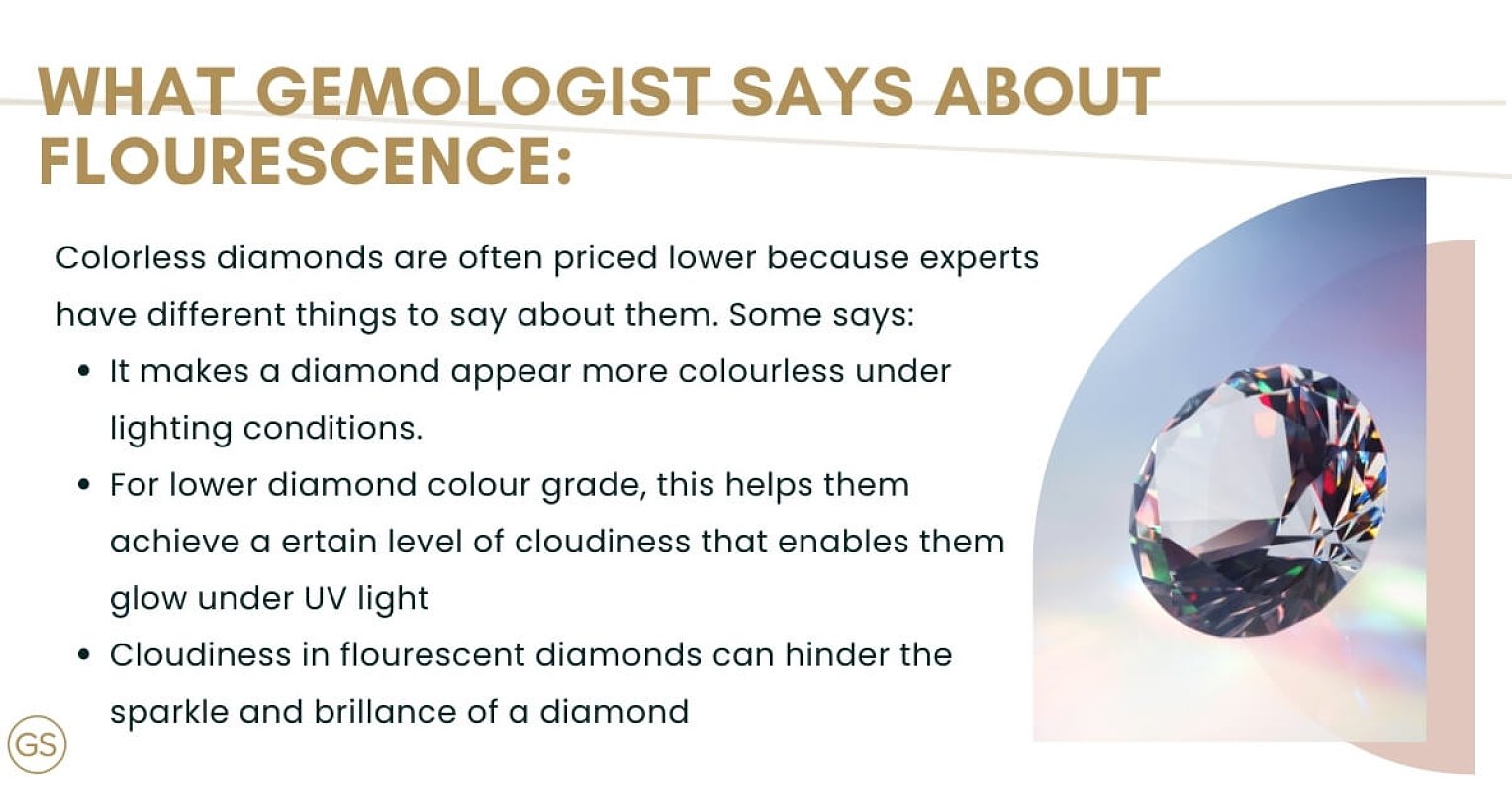
How a diamond absorbs and reflects light is perhaps the biggest factor that contributes to its natural brilliance. Under specialised lighting conditions, however, some diamonds can react in a unique way — they glow.
This curious result is known as diamond fluorescence. In this guide, we’ll help to explain what causes fluorescence in diamonds, as well as the effect it may or may not have on a diamond’s appearance and value.
Diamond fluorescence can be observed when diamonds are placed under a source of ultraviolet (UV) light. Similar to how some white articles of clothing glow under UV light, some diamonds can fluoresce and glow in varying intensities, emitting a vibrant bluish colour.
This unique effect is only seen in about a third of all diamonds. In some extremely rare cases, the fluorescence a diamond emits can appear yellow, orange, or green.

Because fluorescence exclusively comes into effect under UV light, it’s not a significant grading factor for diamonds, unlike the 4Cs, which apply under regular lighting conditions.
However, the uniqueness of diamond fluorescence is a noteworthy characteristic for identifying diamonds, so most diamond retailers will typically include the intensity of a diamond’s fluorescence in listings. GIA’s research regarding fluorescence in diamonds has created five classifications in order of effect strength: None, Faint, Medium, Strong and Very Strong.
It depends on who you’re asking. To most buyers, fluorescence isn’t necessarily the most important factor considered when it comes to choosing a diamond. The 4Cs are a much bigger set of determining factors for diamond quality. Besides, under most usual lighting conditions, fluorescence in diamonds is unnoticeable to the naked eye — so for the average buyer, it’s not a contributing factor.
For experts, fluorescence in diamonds can significantly affect their price and value. There are several theories that are floating around in the realm of diamond research which we will explore below.
Fluorescence in diamonds is neither a good nor a bad thing. For buyers who are worried about fluorescence affecting the diamond’s composition or clarity, you can rest assured that research has found no direct relationship between these factors.
Instead of focusing on how it affects the value of diamonds, what you should be asking as a buyer is whether or not you like the fluorescent effect. Some buyers find the effect so unique that they go out of their way to acquire diamonds that have stronger fluorescence.

Current diamond research is divided on the significance that fluorescence has in determining diamond value.
Some gemologists believe that fluorescence can actually add to a diamond’s overall appearance by making it appear more colourless under lighting conditions. In theory, the bluish hues of fluorescence help to negate some of the yellowish tints present in nearly colourless or faintly coloured diamonds (I to M colour grades). Since natural sunlight consists of UV rays, this effect is thought to be quite significant.
However, research has also shown some correlation between fluorescence and a milky or cloudy appearance. Fluorescent diamonds tend to have a certain level of cloudiness that increases with their ability to glow under UV light. As mentioned above, this can be considered beneficial in lower diamond colour grades, but the same is not true for more colourless diamonds.
The best colourless diamonds have a high level of clarity and transparency that allows light to pass through and reflect off its facets. The cloudiness that is often seen in fluorescent diamonds is thought to hinder this and reduce the overall brilliance of colourless diamonds, making it undesirable.
It’s important to know that fluorescence itself does not affect a diamond’s transparency and colour, as cloudiness can appear in diamonds independent of fluorescence. However, the connection to a perceived reduction in the diamond contrast has caused colourless diamonds with fluorescence to fetch lower prices. However, the connection to a perceived reduction in the diamond contrast has caused colourless diamonds with fluorescence to fetch lower prices.
There’s no practical reason to avoid buying fluorescent diamonds — in fact, doing so can limit your choices when searching for a diamond that meets your budget and preference.
It’s better to think of fluorescence as an additional characteristic of diamonds that has an aesthetic effect under UV light conditions. Outside of these lighting conditions, your diamond will shine as it should.
To see their effect for yourself, you can visit diamond retailer showrooms and ask for an expert to show you the difference. If you do notice a significant difference in the appearance of a fluorescent diamond, the only thing left to ask yourself is if it is to your taste.